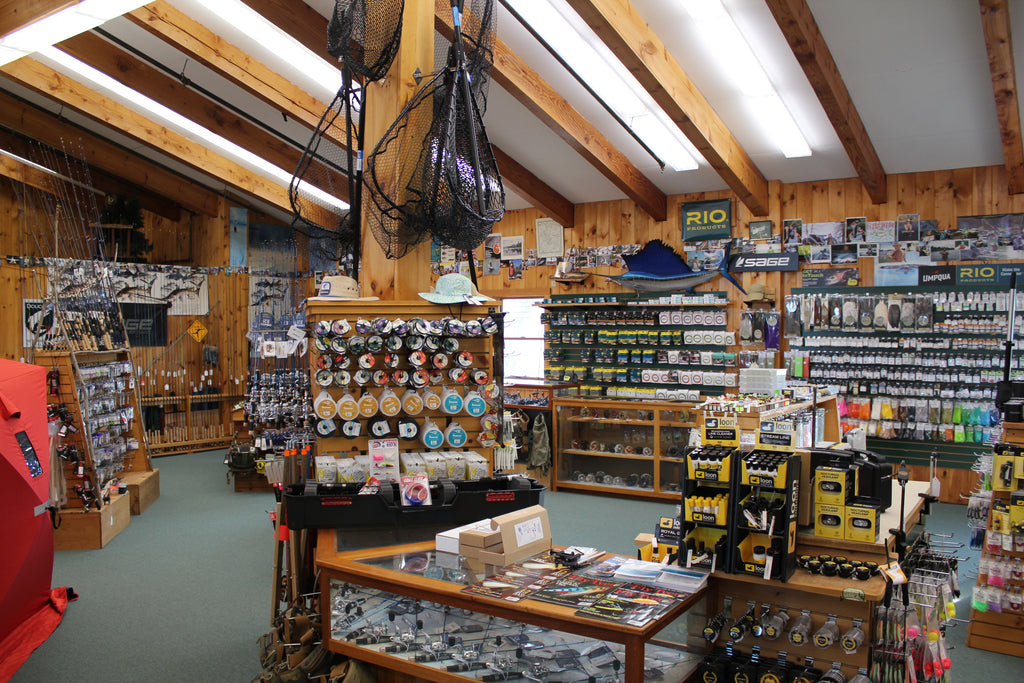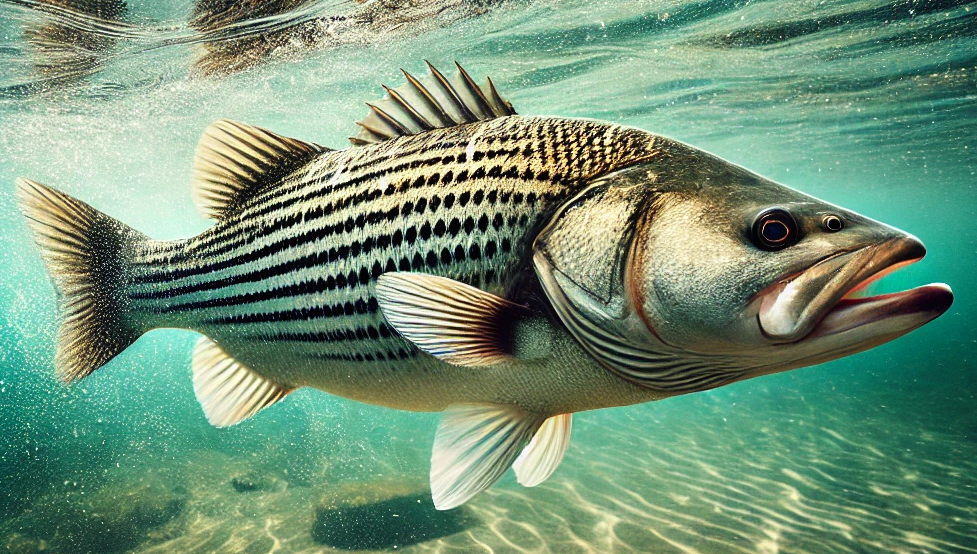Maine's picturesque coastline offers a wealth of opportunities for anglers, and one of the most sought-after catches is the striped bass, locally known as the “striper or linesider." Renowned for their fighting spirit and delicious flavor, stripers draw fishermen from all over to the shores of Maine. Whether you're a seasoned angler or a beginner looking for a thrilling challenge, this guide will help equip you to reel in these prized fish.
For specific information, please see the following articles:
- Beginner's Guide to Catching Striped Bass
- When do Stripers arrive in Maine?
- Where to Find Early Season Striped Bass
Get to Know Striped Bass:
Striped bass are migratory fish found along the Atlantic coast, making their way from their breeding grounds in the Chesapeake and the Hudson River to Maine's waters during the warmer months. They are characterized by their distinctive dark stripes running along their silvery bodies. Stripers prefer coastal waters, estuaries, and river mouths where they hunt for prey such as baitfish, squid, and crustaceans. Striped bass are a gift to shore anglers because striped bass often hang very near shore, well within casting distance of spin and fly anglers.

Best Time and Locations:
In Maine, the prime time for striped bass fishing typically begins in June and lasts until October. During this period, stripers migrate along the coast, offering ample opportunities for anglers to target them. Stripers are generally nocturnal feeders so low light conditions such as dawn and dusk are often productive though they absolutely can be caught during midday. Popular fishing spots include the Kennebec River, Casco Bay, Penobscot Bay, Boothbay Harbor, the waters around Portland, and all along the southern shore to the New Hampshire border.

Equipment Needed:
Fishing Rod and Reel: Choose a medium to heavy-duty spinning or bait casting rod paired with a reel capable of handling strong fish.
Fishing Line: Opt for a braided line with a test strength of at least 20-30 pounds to withstand the striper's powerful runs.
Terminal Tackle: Stock up on a variety of hooks, sinkers, and swivels suitable for different fishing conditions.
Bait and Lures: Live bait such as mackerel are popular choices for stripers though check the regulations because live baits are limited in some watersheds. Alternatively, try artificial lures like swimbaits, spoons, or topwater plugs.
Fly Fishing Gear: Deceivers, clousers, and topwater poppers on floating or intermediate lines are popular. Crab patterns fished on sinking lines are another deadly combination. We recommend a strong rod such as an 8 or 9wt, though a skilled fisherman could run something lighter if he is ready for a fight.
Techniques for Catching Striped Bass:
Bottom Fishing: Fish near structure-rich areas such as rocky ledges, submerged reefs, or underwater structures where stripers like to hide. Use bait rigs or weighted jig heads to present your bait near the bottom and wait for a bite.
Trolling: Troll along coastal areas with diving plugs or tube rigs to cover more water and locate schools of stripers. Vary your trolling speed and depth until you find the optimal combination for attracting strikes.
Casting and Retrieving: When stripers are feeding near the surface or chasing baitfish, cast lures such as poppers, surface plugs, or soft plastic swimbaits into the action. Retrieve your lure with erratic movements to mimic injured prey and trigger aggressive strikes.
Fly Fishing: Striped bass are a favorite quarry of fly anglers and can be taken on all types of flies.
Learn more in The Beginner's Guide to Catching Striped Bass.
When do Striper Arrive in Maine?
Striped Bass Arrival Timeline:
2nd Week of May: Generally, the first migrants show up in the southern Maine waters, south of Portland
3rd Week of May: Portland/Yarmouth/Freeport see their first arrivals
End of May: The Kennebec and nearby rivers often have stripers
July: Striped Bass can be found in large numbers all along the coast
These are general estimates and can vary from year to year.
Fish Types:
Generally small fish, called scouts by the locals, are first, followed by midsized fish a week or two later.
Learn more in When Do Stripers Arrive in Maine.
Fishing for Early Season Striper

Be Mobile
It's always a good idea to be mobile during the early season fishing to locate fish, as more stripers continue the migration into Maine waters. Estuaries, marshes, coastal rivers and warming flats attract fish, and as always, low light conditions favor feeding times.

Mouth of Rivers
While you can and will find striped bass “out front” along the beaches, be mindful that these fish are usually on the move heading elsewhere - usually towards warmer environments. To find fish consistently, you’ll want to focus on the mouths of rivers. On several of the larger Maine rivers, newly arrived stripers will gather at the convergence of a dropping tide and a river mouth, wearing their feed bags, scooping up goodies from the end of an endless conveyer belt. When this happens, it can help to retreat away from river and follow the outflow oceanward as the fish will keep dropping back.
Estuaries and Marshes
Fishing for stripers in the estuaries and marshes in May is a different game. Often the fishing can be almost freshwater-like, with quiet presentations of grass shrimp or crab patterns cast into seams and riffles to fish idling in the current where they will rise like trout to suck in your fly. Wading access can be very tricky in marshes, the holes can be very deep and the water very cold. A misstep can be costly. Fortunately, these environments really lend themselves to fishing off a kayak, canoe, or paddle board. Standing in a kayak, casting delicate presentations to large fish in an estuary filled with peepers and birdsong is truly one of the best fishing moments Maine has to offer.

Mud Flats
Mid-Coast Maine has no shortage of muddy flats and as the sun grows stronger, it heats up the water flooding the flats creating an enticing buffet of crustaceans and small baitfish for the new arrivals. Many anglers (myself included) have to overcome their disbelief that such large fish can be found in a foot or two of water but it happens all the time. This is one of the reasons that striped bass are such a premier gamefish… they literally feed at our feet.
Be Persistent
Persistence pays off in May. The fishing is dynamic, changing every tide as newer and bigger fish arrive. Migratory fish straight from the sea are luminous, their chrome flanks and dark, broken lines glitter in the sun or under a headlamp. Despite the occasional lulls, hardworking anglers can be successful by exploring different locations and adapting tactics. Catching the first striper of the season is a moment to savor, reminding anglers of the miracle of the migration when our finned friends return to fulfill our offseason dreams.
Learn more in Where to Find Early Season Striped Bass.
Fishing For Late Season Striper
Adjust Your Tactics
As the season progresses and water temperatures rise, striped bass behavior changes, and so should your tactics. Start by switching from those early-season jigs and bucktails to surface lures like poppers and spooks, which can trigger aggressive strikes from bass feeding on topwater baitfish. Soft plastics also remain effective, particularly in deeper channels or along rocky shores where fish seek cooler, oxygen-rich water. For fly anglers, larger, unweighted streamers that mimic baitfish are ideal, especially when worked quickly across the surface during dawn or dusk.
Focus on Structure
By late summer, striped bass are more spread out and can be found holding near structure, such as rocks, ledges, and drop-offs. These areas provide ambush points for stripers as they hunt. Spend your time fishing around boulder fields, submerged rock piles, and jetties where bass can take advantage of currents that bring baitfish to them. As always, tide plays a crucial role, with the best fishing often occurring around the change of tides, especially when outgoing water exposes bait-rich shallows.
Night Fishing
With the heat of summer, striped bass often feed more actively at night when the water is cooler. This is the time to break out larger plugs or eels, both live and artificial, as these can entice the biggest fish of the season. Focus on areas with good current and deeper water nearby, such as river mouths and rocky points, where bass will move in to feed under the cover of darkness. Night fishing can be incredibly productive, but it requires patience and a willingness to explore different spots until you find where the fish are holding.
Deeper Waters
As the season wears on, striped bass will often move into deeper, cooler waters during the day, returning to shallower areas only during low light periods or at night. Look for them along the edges of deep channels or off ledges where they can ambush bait. In these conditions, trolling with deep-diving plugs or using heavy jigs can be effective ways to reach fish holding in 20 to 40 feet of water. Pay attention to your electronics to locate schools of baitfish, which will often be accompanied by hungry stripers.
Be Adaptable
Late-season striped bass fishing requires adaptability. The fish are more experienced, and the easy pickings of early summer are gone. Be prepared to change your approach frequently, whether it’s shifting from topwater in the morning to deepwater tactics in the afternoon or changing spots as fish become more scattered. Persistence and a willingness to experiment with different lures, retrieves, and locations will increase your chances of success. The late season is when the largest, most elusive stripers are caught, making every outing a potential for a personal best.
Enjoy the Experience
Finally, remember to enjoy the experience. Late-season striped bass fishing in Maine is about more than just the catch. The cooler evenings, the solitude of night fishing, and the challenge of outsmarting a wary gamefish are all part of what makes this time of year special. Whether you’re casting under a full moon or watching the sun rise over the Atlantic, these moments are what make the pursuit of striped bass in Maine so rewarding.
Regulations:
Before heading out to fish for striped bass in Maine, familiarize yourself with local fishing regulations, currently there is a permissible slot limit where only fish between 28 and 31 inches are allowed to be harvested.
More Info:
Looking for the gear you need? Maine Sport Outfitters in Rockport has a fully equipped spin and fly fishing shop.
Looking for a fishing trip to remember? Book a guided Striper fishing trip with us! Check out our guided fishing trips, available for the waters near Camden, Rockport, and Rockland, Maine. Our guides cannot guarantee a catch, but they certainly provide the best shot one can have at catching striper.

